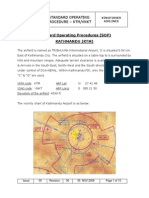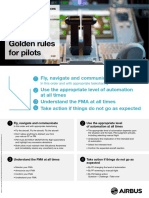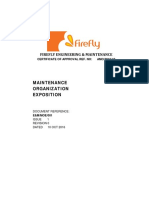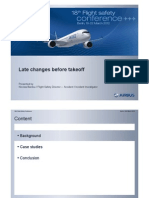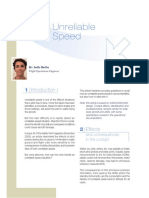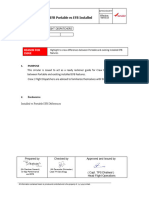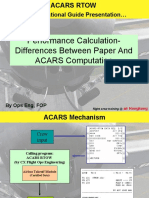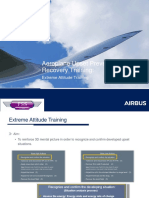Cabin Smoke Awareness
Cabin Smoke Awareness
Uploaded by
Emmanuel AdellCopyright:
Available Formats
Cabin Smoke Awareness
Cabin Smoke Awareness
Uploaded by
Emmanuel AdellCopyright
Available Formats
Share this document
Did you find this document useful?
Is this content inappropriate?
Copyright:
Available Formats
Cabin Smoke Awareness
Cabin Smoke Awareness
Uploaded by
Emmanuel AdellCopyright:
Available Formats
Flight Operations Briefing Notes
Cabin Operations Cabin Smoke Awareness
Flight Operations Briefing Notes Cabin Operations Cabin Smoke Awareness
Introduction
It is important that cabin crewmembers be aware of indications of smoke, report them to the flight crewmembers and respond to. All crewmembers must take all reports of smoke in the cabin seriously. They must immediately identify the source of smoke, and take the appropriate actions in order to significantly minimize the risk of fire onboard the aircraft. It is wise to treat a smoke occurrence as fire, until it has been proven otherwise. The cabin crewmembers must remember that the development of an odor, or smoke, takes some time before it can be detected. Additional information on on how to deal with in-flight fire events is provided in the Flight Operations Briefing Note Managing Fire in the Cabin.
II
Background Information
Analysis of in-service events involving smoke in the cabin has shown: Cases where the cabin crewmembers detected the source of smoke easily Cases where the cabin crewmembers detected the source of smoke with difficulty.
In most cases, the cabin crewmembers reported that the source of smoke was easily identified.
Page 1 of 10
Flight Operations Briefing Notes
Cabin Operations Cabin Smoke Awareness
The following are the areas where the cabin crewmembers can easily detect the source of smoke: Galley equipment (ovens, coffeemakers) represented the most common source of smoke Cabin equipment (e.g. a seat screen or seat control malfunction) Lavatories.
The following are areas where it is difficult for the cabin crewmembers to detect the source of smoke: Air conditioning Sidewall panels Ceiling panels.
Smoke coming from the above areas may be attributed to: The Auxiliary Power Unit (APU) Cabin recirculation fans Cargo compartments Crew Rest Compartments Electrical wiring Engine Air Bleed (e.g. Bird ingestion, ).
Sometimes human error is a contributing factor to some smoke occurrences, such as: Putting a flammable item in an oven (e.g. plastic wrapping left on food during the cooking cycle, ) Leaving an empty coffeemaker on a hot plate Placing a flammable item close to a source of heat (e.g. plastic cups next to a hot oven) Forgetting to check the cleanliness of oven pre-flight (i.e. papers or food grease left in the oven) Smoking in the lavatories.
If it is not possible for the cabin crewmembers to immediately detect the source of smoke, the following consequences may occur: Fire Emergency evacuation Hospitalization of cabin crewmembers and/or passengers due to smoke inhalation Flight delays, In-flight Turn Back (IFTB), diversions.
Page 2 of 10
Flight Operations Briefing Notes
Cabin Operations Cabin Smoke Awareness
III
Operational Standards for a Smoke Occurrence
When the cabin crewmembers identifies and locates smoke, they must apply the appropriate procedures in order to stop the smoke and prevent a fire. Smoke can come from different areas of the aircraft. These areas can be identified as either easy or difficult sources of smoke.
The Easy Sources of Smoke
The cabin crewmembers must take the following actions: Shut off the electrical power by pulling the corresponding circuit breaker, and shutting off the power, if applicable Inform the flight crew immediately Closely monitor the situation Prepare a fire extinguisher, Protective Breathing Equipment (PBE) and fire gloves in case the situation deteriorates.
The Difficult Sources of Smoke
The cabin crewmembers may have limited or no access to areas such as sidewall, ceiling panels, or air conditioning, and may have no way of visually monitoring them. If smoke comes from any of these areas, the cabin crewmembers must take the following actions: Inform the flight crew Closely monitor the situation Prepare a fire extinguisher, Protective Breathing Equipment (PBE), fire gloves in case the situation deteriorates.
Protection from Smoke
Smoke can impair judgment and affect performance. When inhaled even in small quantities, it can be fatal depending on an individuals level of tolerance. Materials that are used in the cabin release toxic fumes when smoldering, such as: Carbon monoxide (CO) Hydrogen cyanide Hydrogen chloride and Acrolein.
Page 3 of 10
Flight Operations Briefing Notes
Cabin Operations Cabin Smoke Awareness
The cabin crewmembers must take the following actions, in order to protect everyone on board, from the negative effects and consequences of smoke inhalation: Do not open the cockpit door, unless it is necessary. Take necessary action to prevent smoke and fumes from contaminating the cockpit Move passengers away from the smoke source area. If this is not possible, encourage the passengers to remain at a low level where the air is clearer Use wet towels, a wet cloth, or a head rest cover to reduce some of the effects of smoke inhalation. Instruct passengers to hold the wet towel/cloth over their noses and mouth and breathe through it.
In addition, the cabin crewmembers should use Protective Breathing Equipment (PBEs) to protect themselves.
Use of Circuit Breaker
Circuit breakers are safety devices, that are designed to interrupt the flow of electrical current to prevent the overheating of wiring and connectors when overloads or short circuits occur. They also help to isolate specific circuits that do not have any other switching device. A circuit breaker will trip, when a predetermined electrical current is detected. A thermal sensing element (e.g. bi-metal) opens the circuit. The cabin crewmembers should pull the circuit breaker related to equipment when they see smoke coming from this equipment. Pulling a circuit breaker will cut off the power source to an electrical item. A circuit breaker is pulled or has tripped automatically, must never be re-engaged by the cabin crewmembers. If a circuit breaker trips, this may indicate a problem. In addition, this problem may be located in an area that is not visible. Re-engaging a tripped circuit breaker may cause more electrical damage and increase the risk of damage to other equipment. The cabin crewmembers must never use circuit breakers as ON/OFF switches for equipment.
Crew Communication / Coordination
If there is smoke in the aircraft, effective crew communication is essential. The information that the cabin crewmembers provides to the flight crew will determines the course of action that the flight crew will take. The cabin crewmembers must inform the flight crew immediately in order to: Limit confusion Increase confidence in decision-making
Page 4 of 10
Flight Operations Briefing Notes
Cabin Operations Cabin Smoke Awareness
Improve the chances of a successful outcome.
Only one cabin crewmember should act as a liaison between the cabin and the flight crew, via the interphone, so as to avoid conflicting information. This cabin crewmember should report: Location of smoke Source (if possible) Severity (density, color, odor, how it is affecting people in the cabin) Any actions taken.
Never underestimate the severity of smoke and fire, when reporting to the flight crew. Do not mention fire, unless flames are visible. In the event of smoke in the cabin, the following actions should be taken by the cabin crewmember who noticed the smoke: Inform the other crewmembers Obtain the nearest firefighting equipment in the cabin Locate the source of smoke Closely monitor the situation.
The other cabin crewmembers must also be ready to perform their assigned duties if the smoke develops into a fire. The in-flight fire fighting procedures are further detailed in the Flight Operations Briefing Note Managing Fire in the Cabin.
IV
Operational and Human Factors Involved in the Detection of Smoke
When smoke is detected in the cabin, the cabin crewmembers must immediately try to identify the source.
IV.1 Operational Factors involved in the Detection of Smoke
Some areas are equipped with smoke detection devices which will alert both flight crewmembers and cabin crewmembers when smoke is detected.
Page 5 of 10
Flight Operations Briefing Notes
Cabin Operations Cabin Smoke Awareness
Smoke Detectors
There is a smoke detector in all lavatories. If smoke enters into the measuring chamber of a smoke detector, a visual and aural warning is transmitted to the cabin and cockpit.
Visual Indications in the Cabin
Visual indicators appear on the following systems in order to notify to the cabin crewmembers that smoke is detected: All Attendant Indication Panels (AIP) The applicable Area Call Panel (ACP) The associated lavatory wall The Forward Attendant Panel (FAP) The Aft Attendant Panel (AAP).
Aural Indications in the Cabin
The following aural indicators will simultaneously trigger, with the visual indicators: A repetitive chime from all the cabin loudspeakers A repetitive chime from all attendant station loudspeakers.
IV.2 Human Factors Awareness)
involved
in
the
Detection
of
Smoke
(Situational
The cabin crewmembers must also use their senses (hearing, touch, smell, vision) to detect smoke. Sometimes, the cabin crewmembers may not see any smoke, but may recognize such indications as: An abnormal noise in the cabin An abnormally warm surface An unusual odor.
Sense of Hearing
Cabin crewmembers and passengers may hear abnormal (snapping, crackling) noises, and should report them. These noises could be caused by electrical arcing of wiring.
Page 6 of 10
Flight Operations Briefing Notes
Cabin Operations Cabin Smoke Awareness
Sense of Touch
When trying to find the source of smoke, the cabin crewmembers should use the back of their hands to check the temperature and/or heat of the various panels and/or doors.
Sense of Smell
The following abnormal odors may indicate the presence of smoke: Acrid odor: Electrical equipment, engine oil leak Burning: Electrical or galley equipment, bird ingestion Chemical odor: Contaminated bleed cuts, Auxiliary Power Unit (APU) fluid ingestion Chlorine: Smoke hood, blocked door area drain Electrical odor: Electrical equipment Fuel odor: APU, Flush Control Unit (FCU)/Fuel line Oil: Engine or APU oil leak Sulphur odor: Wiring, avionics filter water contamination, light bulb.
Sense of Vision
The different panels (Attendant Indication Panels, Area Call Panel) dispatched through the cabin help the cabin crewmembers to detect the presence of smoke in the aircraft.
Operational and Human Factors Affecting Operational Standards
The analysis of in-service events shows that operational standards may not be effective or may be not applicable, due to the following: Ineffective detection of smoke: Odors or smoke may take some time to develop before it can be detected Recirculation of smoke through air conditioning.
Inadequate procedure Incorrect application of the procedure: A cabin crewmember resets a tripped circuit breaker without informing the flight crew about the incident A cabin crewmember does not put an inoperative flag or indicator on a faulty circuit breaker.
Page 7 of 10
Flight Operations Briefing Notes
Cabin Operations Cabin Smoke Awareness
Lack of training: The cabin crewmembers are not proficient enough to accurately perform their respective duties in the event of smoke The cabin crewmember is not proactive or, hesitates to apply the required procedure A cabin crewmember does not know what procedure should be applied (e.g. The crewmember opens the door of an oven that is emitting smoke, ).
Lack of Operator policy: The Operator does not have a policy regarding the use of circuit breakers (C/B).
Ineffective communication with flight crew: A cabin crewmember does not accurately inform the flight crew, by declaring the presence of a fire, without having seen flames. It may cause the flight crew to decide to perform an unnecessary emergency landing Important cabin crewmembers and passengers information may not always be taken into account by the flight crew (odors, noises).
VI
Prevention Strategies
It is important to remember that the source of smoke may quickly develop into an onboard fire, if left undetected. Therefore, both the operator and the cabin crewmembers should take the following preventive actions: The cabin crewmembers should perform a complete pre-flight check including ovens and galleys to ensure that they are clean (papers or any flammable items left in it) The cabin crewmembers should frequently monitor the cabin, galleys (ovens) and lavatories (waste bins) The cabin crewmembers should have good knowledge of the cabin configuration and of all smoke procedures. Operators should provide training and documentation about these smoke-related procedures Operators should ensure that cabin crewmember are medically apt for the flight (e.g. A cabin crewmember does not have a cold that may affect his/her ability to detect the odor of smoke) Finally, operators should adopt a Hands-off policy about tripped circuit breakers. This is to prevent cabin crewmembers performing tripped circuit breakers resets, in any circumstance, and to encourage them to immediately report tripped circuit breakers to the flight crew. Tripped circuit breakers indicate the existence of an abnormal electrical situation, and the possible existence of smoke and/or fire.
Page 8 of 10
Flight Operations Briefing Notes
Cabin Operations Cabin Smoke Awareness
VII
Summary of Key Points
It is important to note the following key points: Operators should develop their policies for cabin safety matters related to smoke in the cabin Operators should plan regular training courses and exercises for its cabin crewmembers. Training exercises should be performed in realistic environments such as in mock-up aircraft, to help the cabin crewmembers to become familiar with cabin smoke events Operators should implement the recommendations issued by aviation authorities in their procedures and training Documentation should be reviewed and updated regularly so that the cabin crewmembers have the most accurate operational standards for smoke events All smoke related events must be recorded using both a flight report and a technical/cabin logbook entry Operators should collect information about incidents that occur during operational flights. This information should be analyzed in order to enhance their procedures and their cabin crew training.
VIII
Associated Flight Operations Briefing Notes
The following Flight Operations Briefing Notes provide additional information about this subject: Effective Briefings for Cabin Operations Crew Communication Managing Fire in the Cabin
IX
Regulatory References
FAA - AC 120-80 In-Flight Fires JAR-OPS 1.1015 Cabin Crew Training Standards
Airbus References
A318/A320/A321, A330, A340 & A380 Cabin Crew Operating Manuals (CCOM) Getting to Grips with Cabin Safety (Brochure) Smoke for Pilots and Cabin Crews (e-briefing)
Page 9 of 10
Flight Operations Briefing Notes
Cabin Operations Cabin Smoke Awareness
XI
Additional Reading Materials / Websites References
Transport Canada TP 12295E Flight Attendant Manual Standard Transport Canada TP 12296E Flight Attendant Training Manual
Note: These manuals are available on the Transport Canada website: http://www.tc.gc.ca/. Flight Safety Foundation Publications - Cabin Crew Safety March-April 2004 When Circuit Breakers Trip, A Hands-Off Policy Prevents Fires
Note: This FSF publication and other FSF Cabin Crew Safety Bulletins are available on the Flight Safety Foundation website: http://www.flightsafety.org/home.html.
This FOBN is part of a set of Flight Operations Briefing Notes that provide an overview of the applicable standards, flying techniques and best practices, operational and human factors, suggested company prevention strategies and personal linesof-defense related to major threats and hazards to flight operations safety. This FOBN is intended to enhance the reader's flight safety awareness but it shall not supersede the applicable regulations and the Airbus or airline's operational documentation; should any deviation appear between this FOBN and the Airbus or airlines AFM / (M)MEL / FCOM / QRH / FCTM / CCOM, the latter shall prevail at all times. In the interest of aviation safety, this FOBN may be reproduced in whole or in part - in all media - or translated; any use of this FOBN shall not modify its contents or alter an excerpt from its original context. Any commercial use is strictly excluded. All uses shall credit Airbus. Airbus shall have no liability or responsibility for the use of this FOBN, the correctness of the duplication, adaptation or translation and for the updating and revision of any duplicated version.
Airbus Customer Services Flight Operations Support and Services 1 Rond Point Maurice Bellonte - 31707 BLAGNAC CEDEX FRANCE
FOBN Reference : FLT_OPS CAB_OPS SEQ 06 REV 01 APR. 2006
Page 10 of 10
You might also like
- SLF Discussion Item NotesDocument67 pagesSLF Discussion Item Notesvidur bangiaNo ratings yet
- Your Flight TicketDocument2 pagesYour Flight TicketSooday Jhaveri100% (1)
- Smoke ProcedureDocument16 pagesSmoke ProcedureNejmeddine HalfaouiNo ratings yet
- Unplanned Ground EvacuationDocument14 pagesUnplanned Ground EvacuationairbusflyNo ratings yet
- Kathmandu Airport SopDocument15 pagesKathmandu Airport SopFlyboyraj100% (1)
- Golden Rules For PilotsDocument1 pageGolden Rules For PilotsmsmNo ratings yet
- Emergency DescentDocument18 pagesEmergency DescentDevdatt SondeNo ratings yet
- LosaDocument58 pagesLosaAmadou OuorouNo ratings yet
- Jet Orientation CourseDocument1 pageJet Orientation CourseMarcelo NobregaNo ratings yet
- A320 Oeb N°44 L:G Gear Not Downlocked PDFDocument31 pagesA320 Oeb N°44 L:G Gear Not Downlocked PDFpilote_a3200% (1)
- CRM AirbusDocument10 pagesCRM Airbussisko320100% (1)
- Moe Issue 1 Rev 0 PDFDocument272 pagesMoe Issue 1 Rev 0 PDFallen don50% (2)
- Galileo Gds Fares Ticketing Clue Card PDFDocument2 pagesGalileo Gds Fares Ticketing Clue Card PDFMarufan NessaNo ratings yet
- SUBJ: Contractions: Order JO 7340.2CDocument526 pagesSUBJ: Contractions: Order JO 7340.2Canon_727999103No ratings yet
- Flight Operations Briefing NotesDocument10 pagesFlight Operations Briefing NotesairbusflyNo ratings yet
- Smoke ProcedureDocument25 pagesSmoke ProceduretheimbachNo ratings yet
- Late Take Off ChangesDocument27 pagesLate Take Off ChangesLbrito01No ratings yet
- Content FCTP A320Document2 pagesContent FCTP A320Lohrasp Suraliwala0% (1)
- Ice and Rain ProtectionDocument10 pagesIce and Rain ProtectionJefferson CuNo ratings yet
- Content FCTP A320Document2 pagesContent FCTP A320Gaurav Sabharwal25% (4)
- VNA - Skype Interview FeedbackDocument3 pagesVNA - Skype Interview FeedbackAndréslo Montoya100% (1)
- MB A32F Engine Failure ECAMDocument42 pagesMB A32F Engine Failure ECAMMarcos Braga100% (4)
- A320-Unreliable Speed IndicationDocument6 pagesA320-Unreliable Speed IndicationDavid Xue50% (2)
- Flight Operations Briefing Notes: Effective Briefings For Cabin OperationsDocument9 pagesFlight Operations Briefing Notes: Effective Briefings For Cabin OperationsGeorgiana ApostuNo ratings yet
- A320 A330 A340 OEB45 BlockedAOAprobes1Document21 pagesA320 A330 A340 OEB45 BlockedAOAprobes1barrigonc33273042100% (1)
- Memory Items Left-Right Seat V3Document19 pagesMemory Items Left-Right Seat V3HeshNo ratings yet
- In Flight Fuel Management and Declaring MINIMUM MAYDAY FUEL-1.0Document21 pagesIn Flight Fuel Management and Declaring MINIMUM MAYDAY FUEL-1.0dahiya1988100% (1)
- EF2MA7Document38 pagesEF2MA7Lohrasp SuraliwalaNo ratings yet
- Eazy Jet QuizDocument13 pagesEazy Jet Quizthe_gov100% (2)
- Specific To The Airbus - The Hidden Memory Items - Airbus Upgrade Technical SiteDocument1 pageSpecific To The Airbus - The Hidden Memory Items - Airbus Upgrade Technical SitevitorpeladoNo ratings yet
- British Airbus Flight Route Airways Training Study Guide Training After TouchdownDocument8 pagesBritish Airbus Flight Route Airways Training Study Guide Training After TouchdownCristianoVelosodeQueirozNo ratings yet
- A320 Abnormal Notes PDFDocument106 pagesA320 Abnormal Notes PDFcaptmon351No ratings yet
- ETOPS Diversion at NightDocument5 pagesETOPS Diversion at NighttugayyoungNo ratings yet
- Airbus Study PrepDocument34 pagesAirbus Study Prepstephenpimley-1100% (2)
- Airbus Tech Quiz 2: ATA21 Air Conditioning - PressurisationDocument15 pagesAirbus Tech Quiz 2: ATA21 Air Conditioning - PressurisationdjNo ratings yet
- A330-Unreliable Speed IndicationDocument8 pagesA330-Unreliable Speed IndicationAlvaro GalindoNo ratings yet
- Ffs ReqDocument30 pagesFfs ReqswathikanagarajanNo ratings yet
- Unreliable AirspeedDocument6 pagesUnreliable Airspeedjunebug172No ratings yet
- 20-21 Icn De-Icing Anti-Icing Pilot Brief SheetDocument12 pages20-21 Icn De-Icing Anti-Icing Pilot Brief SheetMichael Parkanski100% (1)
- Airbus Grading A320Document14 pagesAirbus Grading A320Amadeo GonzalezNo ratings yet
- B777 Portable EFB Differences CircularDocument11 pagesB777 Portable EFB Differences Circulark.vinoth.itNo ratings yet
- A320-A330-A340-A350-A380 Checklist Risk AnalysisDocument22 pagesA320-A330-A340-A350-A380 Checklist Risk Analysisfantabaires86No ratings yet
- P3-Chapter 6 Special Procedures Ok-R5Document26 pagesP3-Chapter 6 Special Procedures Ok-R5ali4957270No ratings yet
- A330 International Procedures PamphletDocument8 pagesA330 International Procedures PamphletA320CaptNo ratings yet
- A320 CBT Navigation: Table of ContentDocument40 pagesA320 CBT Navigation: Table of ContentAman VermaNo ratings yet
- Airbus A320 Family Non-Normal Notes PDFDocument112 pagesAirbus A320 Family Non-Normal Notes PDFCapt Devdatt SondeNo ratings yet
- Instructor Pilots GuideDocument9 pagesInstructor Pilots GuideDomnic Dsilva0% (1)
- A - Loc-I and UprtDocument21 pagesA - Loc-I and UprtaspreyNo ratings yet
- EFQDocument61 pagesEFQPaco Iglesias Cubiles100% (3)
- AP UpsetRecovery BookDocument443 pagesAP UpsetRecovery BookAnonymous H9JbBB5RbRNo ratings yet
- PGS - A320 Simulator Assessment 2022Document13 pagesPGS - A320 Simulator Assessment 2022Samet OzanNo ratings yet
- 1 Reactive Windshear: 1.1 Before V1Document7 pages1 Reactive Windshear: 1.1 Before V1Joao MeloNo ratings yet
- AIRBUS A319/320/321: Sample Oral QuestionsDocument21 pagesAIRBUS A319/320/321: Sample Oral QuestionsnodynarenNo ratings yet
- Flight Operations: WebinarDocument31 pagesFlight Operations: WebinarAmgad Kamel MarzoukNo ratings yet
- A320 Dual Hydraulic Failure G and YDocument4 pagesA320 Dual Hydraulic Failure G and YSherįl Alexx100% (1)
- Performance Calculation-Differences Between Paper and ACARS ComputationDocument18 pagesPerformance Calculation-Differences Between Paper and ACARS Computationaviator_ecaa50% (2)
- Notes About A320 FCTM by Iman Jafarian and MJ - AzadiDocument47 pagesNotes About A320 FCTM by Iman Jafarian and MJ - Azadimohammad javad AzadiNo ratings yet
- UPRTDocument57 pagesUPRTSatyam Shukla100% (1)
- A320-X Introduction GuideDocument37 pagesA320-X Introduction GuidecarlosjricoNo ratings yet
- Flightplan BDocument24 pagesFlightplan BNguyễn Duy DươngNo ratings yet
- LTC AirindiaDocument1 pageLTC AirindiaSUBHAM RAJNo ratings yet
- ZLDHDocument3 pagesZLDHjoker hotNo ratings yet
- YVES DENIS JANVIER, 02NOV - Adi Av1Document2 pagesYVES DENIS JANVIER, 02NOV - Adi Av1hans patrick nazairNo ratings yet
- SBSP - Adc-Sbsp Adc 20221229Document2 pagesSBSP - Adc-Sbsp Adc 20221229CMTD RafaelNo ratings yet
- How To Use Briefing NotesDocument24 pagesHow To Use Briefing NotesKaroon SemNo ratings yet
- Bird StrikesDocument18 pagesBird StrikesRoger SacchelliNo ratings yet
- Status Report Cessna 180Document7 pagesStatus Report Cessna 180cristian ledesmaNo ratings yet
- Complimentary Airport Lounge Access Program Terms ConditionsDocument2 pagesComplimentary Airport Lounge Access Program Terms ConditionsMochammad Reza ZakariaNo ratings yet
- Navigation display (ND) : Kirilchev Vladislav ЛЭ (С) -19Document19 pagesNavigation display (ND) : Kirilchev Vladislav ЛЭ (С) -19Мария ПопелющенкоNo ratings yet
- Round Is Cool !: Icp - ItDocument4 pagesRound Is Cool !: Icp - ItDami HaNo ratings yet
- ATA ChaptersDocument6 pagesATA ChaptersNaser MahmudNo ratings yet
- SP's Aviation April 2010Document52 pagesSP's Aviation April 2010SP Guide PublicationsNo ratings yet
- Capacity Management in Airline Industry: A Case Study: Analysis ofDocument6 pagesCapacity Management in Airline Industry: A Case Study: Analysis ofMyles Ninon LazoNo ratings yet
- NF2EMFBISLUEUV831494 ETicketDocument4 pagesNF2EMFBISLUEUV831494 ETicketMohd AhmadNo ratings yet
- RNAV' Approach Charts Renamed RNP'Document2 pagesRNAV' Approach Charts Renamed RNP'ironI666No ratings yet
- WW2 Wings of Glory - Climb RatesDocument2 pagesWW2 Wings of Glory - Climb Rateswachu73No ratings yet
- Foreign Technology DivisionDocument467 pagesForeign Technology DivisionArashNo ratings yet
- Checklist 9 Checklist For Approval of Maintenance Organization Exposition Ncar Part 145Document58 pagesChecklist 9 Checklist For Approval of Maintenance Organization Exposition Ncar Part 145Abhishek Man ShresthaNo ratings yet
- Kam Air Flight Accident: 1 HamidiDocument9 pagesKam Air Flight Accident: 1 HamidiWaqas D. HamidiNo ratings yet
- New - Galileo Basic Entries - Dec 2016Document4 pagesNew - Galileo Basic Entries - Dec 2016praveen v100% (1)
- Pengesahan - Daftar MasukDocument5 pagesPengesahan - Daftar MasukMax VNo ratings yet
- Airbus a380 Fctm (2011)Document370 pagesAirbus a380 Fctm (2011)Yonatan KosarevNo ratings yet
- Certificado TipoDocument168 pagesCertificado TipoAndresLopezMllanNo ratings yet
- Economy Confirmation / This Is Not A Boarding Pass: Nair / Rajeev Eriyalath Ramkumar TG318 / 10APRDocument2 pagesEconomy Confirmation / This Is Not A Boarding Pass: Nair / Rajeev Eriyalath Ramkumar TG318 / 10APRjyothi nairNo ratings yet
- Service Bulletin No. Rsb1078-180/1: I. Technical DetailsDocument4 pagesService Bulletin No. Rsb1078-180/1: I. Technical DetailsAbdul Majeed SurmawalaNo ratings yet





